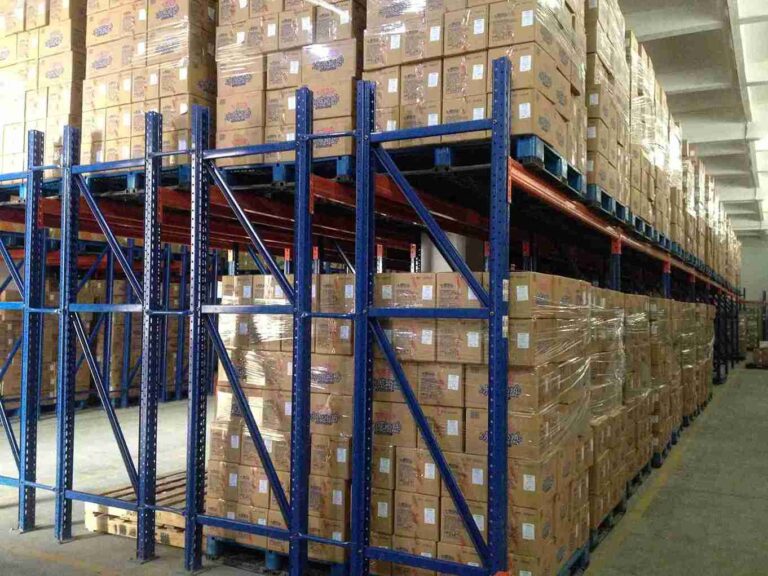📐"前 50 个企业查询可获得定制 3D 仓库设计" 计划

Introduction
In today’s competitive logistics landscape, warehouse operators face mounting pressure to maximize storage capacity while controlling costs. The double deep racking system has emerged as an industry-leading solution, enabling facilities to increase pallet positions by up to 40% without physical expansion. This innovative approach represents a paradigm shift in high-density storage, combining space efficiency with operational practicality.
Unlike conventional single-row configurations, double deep racking utilizes a two-pallet-deep design that dramatically reduces aisle space requirements. For a typical 100,000 sq. ft. warehouse, this can translate to 10,000+ additional pallet positions – enough to delay or eliminate costly facility expansions.

1. System Mechanics and Operation
1.1 Core Design Features
The double deep racking system arranges pallets in back-to-back rows, effectively doubling storage depth. This configuration:
-
Reduces aisle space by 30-40% compared to selective racking
-
Maintains 8-10 ft. narrow aisles for forklift access
-
Supports standard pallet sizes (48″x40″ most common)
1.2 Operational Requirements
Successful implementation requires:
-
Extended-reach forklifts (minimum 12′ reach capability)
-
LIFO (Last-In, First-Out) inventory management
-
Uniform pallet dimensions and weights
-
Minimum 13’6″ clear ceiling height
2. Transformative Business Benefits
2.1 Space Optimization
The most compelling advantage is the dramatic increase in storage density. Case studies show:
-
Beverage distributor: +38% capacity in existing facility
-
Automotive parts: 42% more SKUs without expansion
-
Cold storage: 35% energy savings from reduced airspace
2.2 Operational Improvements
-
25-30% reduction in forklift travel distance
-
15-20% faster order picking times
-
Lower HVAC costs in temperature-controlled environments
3. Comparative Analysis
3.1 Versus Alternative Systems
| Feature | Double Deep | Selective | Drive-In |
|---|---|---|---|
| Storage Depth | 2 pallets | 1 pallet | 4-6 deep |
| Accessibility | Moderate | High | Low |
| Best For | Medium-SKU | High-SKU | Bulk |
3.2 Cost-Benefit Considerations
While requiring specialized forklifts (65,000−85,000 each), the system offers:
-
18-24 month ROI for most operations
-
30-40% lower maintenance than pallet flow systems
-
Better damage prevention than drive-in alternatives
4. Industry-Specific Applications
4.1 Retail Distribution
Major big-box retailers have adopted double deep racking for:
-
Backstock storage of promotional items
-
Seasonal inventory management
-
E-commerce fulfillment centers
4.2 Manufacturing Support
Production facilities benefit from:
-
Raw material buffer storage
-
WIP (Work-in-Progress) staging
-
Finished goods consolidation
5. Implementation Roadmap
5.1 Assessment Phase
-
Current storage analysis
-
Throughput requirements
-
Growth projections
5.2 Design Considerations
-
Optimal beam levels
-
Load capacity planning
-
Future expansion provisions
6. The Future of High-Density Storage
Emerging innovations include:
-
Automated guided vehicle integration
-
AI-powered slotting optimization
-
IoT-enabled load monitoring
7. Installation & Maintenance
7.1 Setup Requirements
-
Proper floor preparation
-
Adherence to load specifications
7.2 Ongoing Care
-
Regular safety inspections
-
Operator training programs
8. Future Developments
-
Integration with automated retrieval systems
-
Advanced warehouse management software compatibility
9. Conclusion
For operations facing space constraints, double deep racking delivers measurable improvements in storage utilization and operational efficiency. With proper implementation, facilities can typically achieve:
-
35-40% capacity increase
-
20-25% productivity gains
-
15-20% energy savings
To explore how this solution could transform your operation, request a complimentary storage analysis from our warehouse design experts.
10. Common Questions
10.1 Equipment requirements?
Specialized reach trucks are necessary for operation.
10.2 Inventory rotation?
Designed for LIFO systems; other options available for FIFO needs.
10.3 Height limitations?
Typically supports up to 40-foot elevations based on equipment.
10.4 Compared to flow systems?
Better suited for consistent SKUs versus high-variability inventory.
10.5 Implementation timeline?
Generally 4-8 weeks depending on facility specifics.
Conclusion
For operations facing space constraints, double deep racking delivers measurable improvements in storage utilization and operational efficiency. With proper implementation, facilities can typically achieve:
-
35-40% capacity increase
-
20-25% productivity gains
-
15-20% energy savings
To explore how this solution could transform your operation, request a complimentary storage analysis from our warehouse design experts.




